Throughout history, many religions have been introduced into Vietnam, enriching the spiritual life of the local people.

But Vietnamese people are not religious fanatics. The local religions and beliefs have harmonized and complemented each other. In each individual or family, they all worship ancestors, god emperors, both Buddha and Confucius. This mixture is a great feature, showing the religious integration of Vietnamese people in the past and present.
In spite of that, you can also find many religions in Vietnam that are practiced and become more and more famous among the locals. So, here are the five popular religions that form the cultural belief in the beautiful country.
1. Buddhism
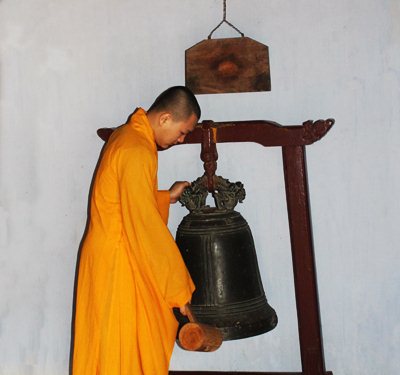
Buddhism occupies an important role in the Vietnamese spiritual life, becoming the most popular religion that many local people believe in. According to different sources, the number of Buddhists accounts for 4.79% (1919) – 14.91% (1918) of the country’s population.
In reality, there are a large number of people influenced by Buddhist culture and regularly visit temples in Vietnam.
Thus, hundreds of pagodas have been built throughout the country, you can easily find many ancient ones over 100 years old. Many of them become famous tourist destinations for exploring classic architecture and learning about Buddhism.
Both branches of Buddhism, Mahayana and Hinayana, are present in Vietnam. Among them, Mahayana appears widely in the North and Central, and Hinayana expands in the South.
Although the practice is different, the common point of these two branches of this religion is to direct people to good things, find peace of mind and soul, and help them get rid of the stress of busy life.
2. Confucianism
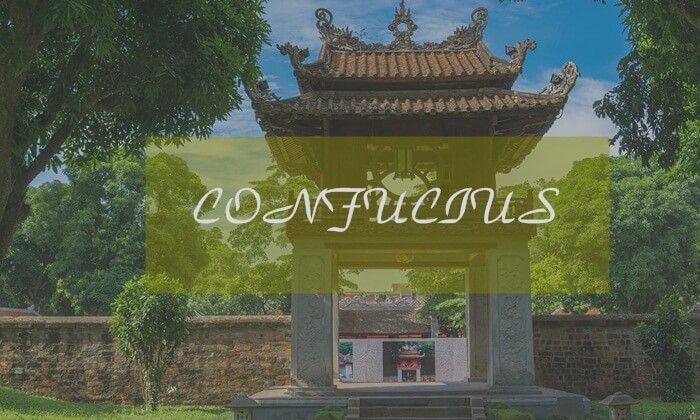
Confucianism appeared in Vietnam quite early, but the 2nd century had been considered the beginning of the development of this doctrine.
In the Ly Dynasty (XI-XII centuries) and the beginning of the Tran Dynasty (13th century), Confucianism was developed along with Buddhism and Taoism. In 1070, Van Mieu Quoc Tu Giam – the first university of Vietnam was established to train Confucian scholars and mandarins. From the end of the Tran Dynasty (XIV), Confucianism developed stronger and began to gradually overwhelm Buddhism.
Confucianism is a religion or doctrine, which emphasizes how to teach morality to become a good person in family and society.
Because of too much emphasis on moral teaching, Confucianism neglects to train people to adapt to the brilliant development of modern science and technology and new production skills. Therefore, this is a terrible limitation, making many people in Vietnam who are no longer interested in this doctrine.
However, the influence of Confucianism is still quite a lot in life here. Therefore, this is a local cultural difference, forming an attraction for many foreign tourists. And, you will also have the opportunity to explore this difference if you choose to come to Vietnam in your abroad journey.
3. Christianity with Catholicism and Protestantism
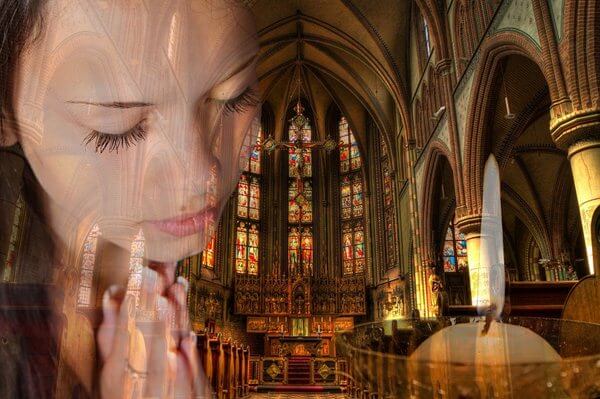
Christianity, mainly Catholic, was introduced to Vietnam from the 15th to the 16th centuries, but until the 17th century, missionary work was really effective.
Christianity has a system of doctrines, rituals, and beliefs to strongly influence the psychology of believers, making them believe absolutely in the miracle of God and live patiently on earth to achieve eternity, forever in heaven.
In the early years of being introduced to Vietnam, Christianity was strictly banned by the local feudal government. After France established a dominant system in the country, Christianity entered a new phase, developing at a rapid pace.
In Vietnam today, the places where many Catholics are concentrated are the Bui Chu and Phat Diem areas of Ninh Binh Province and the Ho Nai and Bien Hoa areas of Dong Nai Province. The number of Christians in the country accounts for around 5.5% of the total population.
After the introduction of Catholicism, Protestantism was also introduced in Vietnam, but it was less popular. Currently, the followers of Protestantism are concentrated mainly in the Central Highlands of Vietnam. Hanoi City also has an ancient Protestant church in Hang Da Market Street.
4. Cao Dai Religion
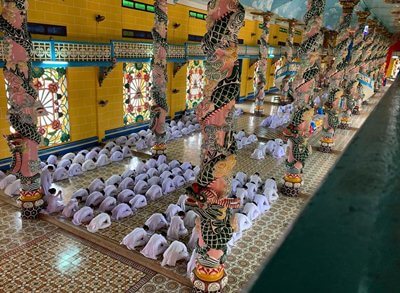
Cao Dai religion was established in October 1926, the founder is Le Van Chieu, and a group of members (28 people). The founders of the Cao Dai religion called their religion “Dai Dao” – the Great Religion, which brought together all religions into a single one.
The religious center in Tay Ninh region, developed mainly in the South, then also developed in the North as Cao Dai Thanh That in 48 Hoa Ma, Ngo Thoi Nham Street, Hai Ba Trung District, Hanoi.
Cao Dai advocates developing one religion for all followers. That thought is expressed on the altars of Cao Dai temples. The highest place is to worship one celestial eye, symbolizing the supreme being who can see through the world, behind the eye is the light that is always lightening. Under the eye, one side has a sword (cutting worldly strings), and one side a brush – Phat Tran (sweeping dust of life). At the bottom are: Lao Tzu, Sakyamuni, and Confucius (Three Teachings of the Way).
The organizational system of the Cao Dai religion is quite large, including many divisions, and a complex system.
Cao Dai religion seems to have no doctrine of its own, borrowing the teachings of Confucianism, Buddhism, Taoism, and even Christianity.
Through the process of formation and development, the Cao Dai religion had complicated developments. But, in general, the majority of the masses, followers of Cao Dai dignitaries, have a patriotic spirit and made active contributions to the two resistance wars, contributing to the cause of national liberation. Currently, the Cao Dai religion has over 2 million followers.
>> A tour includes visiting Cao Dai Temple and its ceremony in Tay Ninh.
Hoa Hao Buddhism
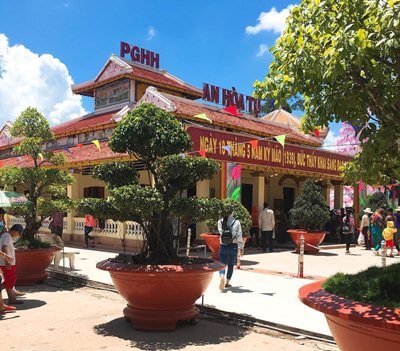
Hoa Hao Religion is a major religion in the Mekong Delta of Vietnam, born in 1939, in Hoa Hao village, Cho Moi district, Long Xuyen town, An Giang province, Vietnam. The founder is Huynh Phu So.
According to religious books, Huynh Phu So was originally a contemplative person, gifted in writing and rhyme, or sick, with a basic education level of French and Vietnamese.
Due to a long illness, Huynh Phu So went to Cam Mountain to find a healer. In 1937, after recovering from his illness, he returned to his hometown. He told everyone that he had met a fairy, a Buddha, and had been treated by a fairy, and taught him many remedies.
Moreover, the Buddha gave him the mission to save the world. At this time, the Cho Moi area in his hometown always had floods, failed crops, and people were hungry and sick. Huynh Phu So used herb medicine to cure diseases, and at the same time composed the oracle and began to preach. In a number of suttas, he had anti-corruption, anti-corruption, and anti-exploitation, so the crowd was quite large starting following him.
The teachings of the Hoa Hao religion are mainly based on the teachings of Buddhism, advising people to be gentle. The altar does not worship statues but only red cloth curtains, worshiping Buddha with filtered water, incense, and flowers.
The Hoa Hao religion has no monks, but only a few dignitaries who take care of religious and world affairs and have no place of public worship. The center of religion in Hoa Hao Village, called Tổ Đình, is also of a family nature.
Hoa Hao religion thrives in Long Xuyen, Chau Doc, Sa Dec, and Can Tho. Hoa Hao followers now have about two million people, mainly concentrated in the Southwest region of Vietnam.
Vietnamdrive’s thoughts
Exploring and learning about religions is one of the interesting experiences when visiting Vietnam. It is also a good way of discovering the culture of indigenous people.
In particular, Buddhism has a lot of attention from foreign tourists. Plenty of temples in Vietnam from the north to south always attract many visitors to pray and visit.
In Hanoi, you can explore Tran Quoc Pagoda, one of the prominent temples in the North. Coming to Hue City, you can visit more temples like Thien Mu Pagoda, Tu Hieu Temple, etc. And in Ho Chi Minh City, you can spend time in Vinh Nghiem and Giac Lam pagodas.
If you have a longer time and want to learn deeply about Buddhism in Vietnam, some temples in Hue City or HCMC will be convenient places, where you can find a few lessons to study and experience.
Typically, Hue has many ancient temples and is considered the center of Buddhism in Vietnam.
For Christians, in addition to Saigon Notre Dame Cathedral in Ho Chi Minh City, two great churches in Hue City, Phu Cam Church and Redemptorist Church, are also attracting many believers.
Despite that, many people believe that the holy place, where Mother Maria appeared in Vietnam, is the Holy Land of La Vang (Thanh Dia La Vang) in Quang Tri province.
In general, each religion has its beauty and charm. Studying it can help you to understand more about the culture in Vietnamese life and thoughts.